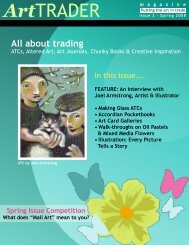Beginner's - ArtTrader Magazine
Beginner's - ArtTrader Magazine
Beginner's - ArtTrader Magazine
You also want an ePaper? Increase the reach of your titles
YUMPU automatically turns print PDFs into web optimized ePapers that Google loves.
Art TRADER<br />
m a g a z i n e<br />
Critique Corner!<br />
D<br />
-47-<br />
With Andrea Melione<br />
Welcome back to Critique Corner, where readers can submit their artwork for a friendly and helpful<br />
evaluation. Email us at <strong>ArtTrader</strong> Mag (andrea@arttradermag.com) if you’d like your work to be<br />
critiqued!<br />
First is a card by Nora Lundquist. She writes, “I know it’s not working, I just can’t figure out why.” This<br />
is a common problem: The artist likes what they have done for the most part, but can’t determine why<br />
the whole piece isn’t coming together. It is obvious from looking at the card that effort was taken in<br />
the various techniques: the embossing; the selection of the image stamp image, and metal charm,: the<br />
beadwork: and the painted details of the border. All of which obviously took some time, as the colors<br />
coordinate very well!<br />
However, this is a good example of the artist focusing a lot on the selection of materials used, and<br />
applying the materials, but less attention to how those materials will work together. Nora has made a<br />
good first step thinking about how it all can work together in terms of color, but you should also think<br />
about how they will work together in terms of texture, placement, and how they will work with the<br />
background; meaning the card/canvas/fabric used as the surface to which everything is applied.<br />
The first thing that strikes me about this card<br />
is the background: It appears to be either<br />
a white or cream cardstock. There is little<br />
tonal (dark/light) or color variation going on.<br />
When creating a mixed media card, it’s a<br />
great idea to create a background first. Use<br />
paints, scrapbook paper, tissue paper, melted<br />
crayon etc. to create a background to place<br />
your visual elements on. This will help your<br />
elements and images to look grounded, part<br />
of the background, rather than just lying on<br />
top of it. Nora’s images have no connection<br />
to their background.<br />
In a card that is completed like this, however,<br />
one could take watercolors and color the<br />
embossed stamp and surrounding areas.<br />
This card is also a good example of tangents. The fairy image is right next to the embossed moon and<br />
the wing is touching it. To achieve a sense of depth, the fairy wing could overlap the moon, to indicate<br />
that the fairy is closer.




